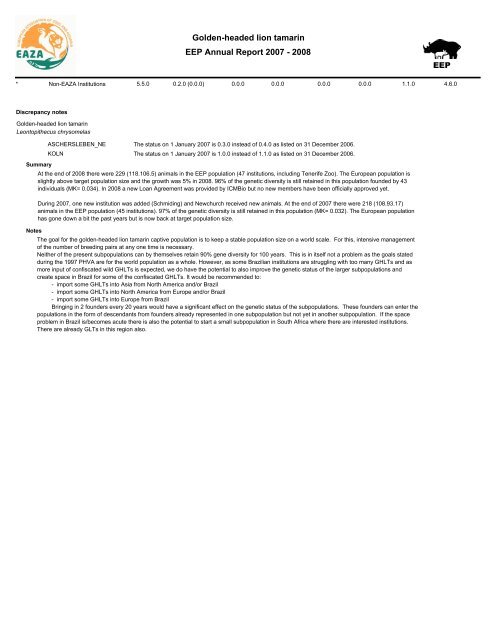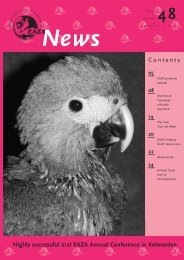EAZA Yearbook 2007/2008
EAZA Yearbook 2007/2008
EAZA Yearbook 2007/2008
You also want an ePaper? Increase the reach of your titles
YUMPU automatically turns print PDFs into web optimized ePapers that Google loves.
Golden-headed lion tamarin<br />
EEP Annual Report <strong>2007</strong> - <strong>2008</strong><br />
* Non-<strong>EAZA</strong> Institutions 5.5.0 0.2.0 (0.0.0) 0.0.0 0.0.0 0.0.0 0.0.0 1.1.0 4.6.0<br />
Discrepancy notes<br />
Golden-headed lion tamarin<br />
Leontopithecus chrysomelas<br />
Summary<br />
Notes<br />
ASCHERSLEBEN_NE The status on 1 January <strong>2007</strong> is 0.3.0 instead of 0.4.0 as listed on 31 December 2006.<br />
KOLN The status on 1 January <strong>2007</strong> is 1.0.0 instead of 1.1.0 as listed on 31 December 2006.<br />
At the end of <strong>2008</strong> there were 229 (118.106.5) animals in the EEP population (47 institutions, including Tenerife Zoo). The European population is<br />
slightly above target population size and the growth was 5% in <strong>2008</strong>. 96% of the genetic diversity is still retained in this population founded by 43<br />
individuals (MK= 0.034). In <strong>2008</strong> a new Loan Agreement was provided by ICMBio but no new members have been officially approved yet.<br />
During <strong>2007</strong>, one new institution was added (Schmiding) and Newchurch received new animals. At the end of <strong>2007</strong> there were 218 (108.93.17)<br />
animals in the EEP population (45 institutions). 97% of the genetic diversity is still retained in this population (MK= 0.032). The European population<br />
has gone down a bit the past years but is now back at target population size.<br />
The goal for the golden-headed lion tamarin captive population is to keep a stable population size on a world scale. For this, intensive management<br />
of the number of breeding pairs at any one time is necessary.<br />
Neither of the present subpopulations can by themselves retain 90% gene diversity for 100 years. This is in itself not a problem as the goals stated<br />
during the 1997 PHVA are for the world population as a whole. However, as some Brazilian institutions are struggling with too many GHLTs and as<br />
more input of confiscated wild GHLTs is expected, we do have the potential to also improve the genetic status of the larger subpopulations and<br />
create space in Brazil for some of the confiscated GHLTs. It would be recommended to:<br />
- import some GHLTs into Asia from North America and/or Brazil<br />
- import some GHLTs into North America from Europe and/or Brazil<br />
- import some GHLTs into Europe from Brazil<br />
Bringing in 2 founders every 20 years would have a significant effect on the genetic status of the subpopulations. These founders can enter the<br />
populations in the form of descendants from founders already represented in one subpopulation but not yet in another subpopulation. If the space<br />
problem in Brazil is/becomes acute there is also the potential to start a small subpopulation in South Africa where there are interested institutions.<br />
There are already GLTs in this region also.<br />
EEP

















